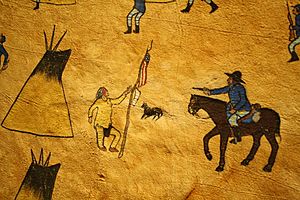Black Bear (chief) facts for kids
Black Bear (who died on April 8, 1870) was an important Arapaho leader in the 1860s. During this time, the Northern Arapaho, like many other Native American tribes, found it hard to hunt and live in their traditional lands. This was because many European-American settlers moved west during the Pike's Peak Gold Rush.
Conflicts started over land and the trails settlers and miners used. A very sad event was the Sand Creek massacre in 1864. After this, the Northern Arapaho joined other tribes to try and stop settlers from taking their lands. In 1865, Black Bear's village was attacked during the Battle of the Tongue River. Many people died, homes were burned, and food was destroyed. This made it very difficult for his people to survive. Black Bear himself died during an attack by white settlers on April 8, 1870, in what is now Wyoming.
Contents
Arapaho History and Challenges
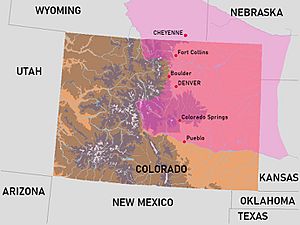
In the 1800s, the Arapaho people lived in a large area. They ranged north of the Arkansas River and east from the Medicine Bow Mountains in the Rocky Mountains. They also lived north and east into the plains. Around the 1820s or 1830s, when they first met European-Americans, the Arapaho split into Northern and Southern groups. This split happened because of where they traded.
Trading posts for British, French, and Americans were set up north of the Arkansas River. South of that, Native Americans traded with the Spanish in the southwest. It was easier to get horses there. The Northern Arapaho had four main groups. They traveled separately to find food but came together for special events like the Sun Dance.
In 1851, the Fort Laramie Treaty was made between Native Americans in the Western United States and the U.S. government. Native Americans, including the Arapaho, wanted to protect their hunting grounds and buffalo herds. The U.S. government wanted to protect settlers moving west. They also wanted to protect trails like the Oregon Trail.
The Arapaho tried to follow the treaty. But they faced starvation because the number of buffalo dropped sharply. Many settlers arrived during the Pike's Peak Gold Rush in the Rocky Mountains. The U.S. government wanted to move Native Americans to special areas called reservations. They also wanted them to become farmers and Christians.
In 1859, Medicine Man, a Northern Arapaho leader, spoke about their struggles. He said, "our sufferings are increasing every year… Our horses, too are dying because we ride them so far to get a little game for our Lodges. We wish to live…" Medicine Man and Black Bear were seen as the two most important Northern Arapaho leaders at that time. Another Arapaho leader named Friday was a good interpreter. He helped talk with the U.S. government.
The Sand Creek Massacre
In late 1864, a peaceful Arapaho and Cheyenne village was attacked. It was located on Sand Creek in eastern Colorado. Colorado troops carried out this attack. About 200 people, mostly women and children, were killed.
In response, Arapaho, Cheyenne, and Lakota people started fighting back. They fought against Euro-Americans on the westward trails.
Conflicts from Westward Expansion

The number of Northern Arapaho people became smaller. But there were still three main groups. Black Bear's group lived in the Powder River Basin. They moved between the Black Hills in the east and the Bighorns. They also ranged to the North Platte basin. Wyoming and Montana still had enough buffalo to support the tribe. Black Bear's group married into the Lakota people.
Another group, led by Friday, lived near the Cache la Poudre River (now Fort Collins, Colorado). A third group, led by Medicine Man, lived near the Sweetwater and North Platte River. As the military built more forts, the Cheyenne and Arapaho wanted to remove European-Americans. They wanted them off the land given to them in the 1851 treaty.
In April 1865, Black Bear and 400 people from his group were given land. This land was along the Tongue River in the Powder River Basin. In return, they promised to keep the peace. Medicine Man's and Black Bear's groups left their camp near Fort Collins, Colorado, for the Tongue River area. They joined with Friday and Wolf Moccasin's groups. These groups had been in the Tongue River area since July 1864.
Black Bear and Medicine Man arrived there by June 1865. They chose to live their traditional way of life, hunting buffalo for food. They did not take government food supplies. Following the lead of Cheyenne and Sioux natives, Black Bear and Medicine Man led their groups. They fought against travelers on the Overland and Oregon Trails starting in June. They returned to the Tongue River area in August. By then, they were blamed for many attacks on the mail route west of Denver. Black Bear then left the women and children there. He and some warriors went to fight the Crows on the Bighorn River.
The Battle of Tongue River
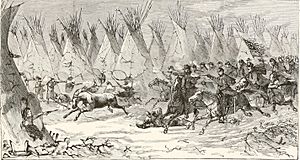
In the early morning of August 29, 1865, near what is now Ranchester, Wyoming, a battle took place. About 125 cavalry soldiers and 90 Pawnee Scouts, led by General Patrick Edward Connor, attacked an Arapaho village. This village, belonging to Chief Black Bear and Old David's group, was in northeastern Wyoming along the Tongue River.
General Connor was sent to the Powder River area. His goal was to fight local Native Americans. He wanted to stop them from attacking miners and settlers on the Bozeman and other trails. This was part of the Powder River Expedition. Connor's aim was to "attack and kill every male Indian over twelve years of age."
The attack, called the Battle of the Tongue River, involved shotguns, bows and arrows, and hand-to-hand fighting. The U.S. Army also used howitzers, which caused great damage to the group of 500 to 700 people. Women and children ran for safety, chased for ten miles by soldiers on horseback.
Black Bear's group gathered again. They launched a counter-attack. This forced Connor and his troops back to Fort Connor (later Fort Reno). They also went to an artillery spot near the Arapaho village. From a hilltop, the Arapaho watched their village burn to the ground. About 180 or 250 homes were destroyed. Their belongings and food stored for winter were ruined. Dead group members were burned with the village. The soldiers also took about 1,000 horses.
Captain Parker said, "Unfortunately for the women and children, our men had no time to direct their aim; bullets from both sides and murderous arrows filled the air; squaws and children, as well as warriors, fell among the dead and wounded."
The attack led to the deaths of men, women, and children. Some who survived were captured. Black Bear's son was among those who died. Losing so many people and resources, the Arapaho needed to work with other tribes for shelter, food, and safety. They were also at risk from diseases like cholera and smallpox that were spreading through their group.
Bozeman Trail War (1866–1868)
The Northern Arapaho joined forces with the Cheyenne and Sioux people. They fought together in December 1866 against Sawyers' Expedition. They also fought in other battles over the next ten years. Black Bear worked with Red Cloud and Sioux warriors. He led his group through conflicts along the Bozeman Trail, known as Red Cloud's War, between 1866 and 1868.
With Medicine Man and other Arapaho leaders, Black Bear met with Peace Commissioners in 1868. They wanted to live more peacefully on their own reservation in Wyoming.
Fort Laramie Treaty of 1868
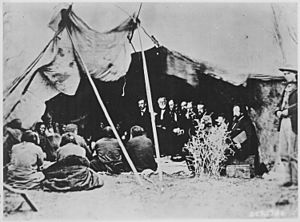
Black Bear was one of the leaders who signed the Treaty of Fort Laramie of 1868. This treaty allowed the Arapaho to keep hunting in the Powder River Basin. However, no reservation was set up just for the Northern Arapaho. They had choices to live at three other reservations. One was in Indian Territory (now Oklahoma) with Southern Arapaho and Cheyenne relatives. Another was with the Crows in Montana Territory. The third was on the Missouri River with the Lakotas. If they stayed on a reservation, they were promised farm equipment, schools, and food supplies for 30 years.
Black Bear and Medicine Man kept looking for a reservation solution for the Northern Arapaho. They suggested a former Army post along the North Platte River in Wyoming Territory. The government suggested that Northern Arapaho people live with the Gros Ventre in northern Montana Territory. About 160 homes of Arapaho people lived there during the winter of 1868 to 1869. They left in the spring because of a smallpox outbreak.
Later Years and Black Bear's Death
Black Bear and Medicine Man tried to build better relations with the U.S. Army. By 1868, some men from their groups became scouts. The Northern Arapaho leaders also tried to improve relations with the Shoshone, who had been their enemies. Many Arapaho people lived on the Shoshone reservation in Wyoming for a while. The Shoshone reservation helped keep Black Bear and Medicine Man's groups in Wyoming. They wanted to live in Wyoming, but it was difficult to live among the Shoshone.
The Northern Arapaho groups found it harder and harder to hunt enough game to feed their people. They started to rely on government food supplies. Miners and settlers crossed into Native American lands along the Sweetwater and Popo Agie Rivers. This led to occasional small fights. In February 1870, Black Bear and Medicine Man were allowed to stay on Shoshone land. But this agreement did not last long. This was partly because the Shoshone had joined with the Crows, who were enemies of the Cheyenne, Sioux, and Arapaho.
The Black Bear Battle
Northern Arapaho people arrived at the Wind River Indian Reservation in March 1870. On March 31, 1870, seven miners were killed during an attack. White settlers blamed the Arapaho, Cheyenne, and Sioux for this. A group of volunteer soldiers left South Pass, Wyoming, to find the Native Americans involved in the attack.
The Arapaho had a camp in the Wind River Valley. A group of white people, along with Shoshone and Bannocks, attacked Black Bear. They attacked his family and his unarmed group as they traveled to Camp Brown (Fort Washakie) for trading. This attack was called the Black Bear Battle. Black Bear and up to 16 others were killed. His wife and child, and seven other children, were captured. One of the children was Destchewa ("Runs on top of ice"). He was adopted by Captain Charles A. Coolidge and his wife and renamed Sherman Coolidge.
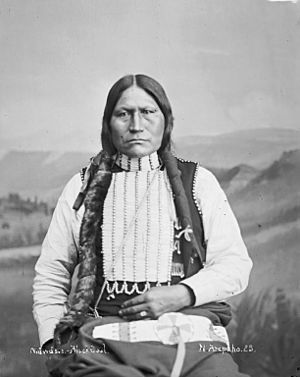
After Black Bear's death, his group split up. Some went to Colorado Territory, led by Chief Friday. Others went to the Milk River Agency to live with their relatives, the Gros Ventres. Most of them gathered at Fort Fetterman by August 1870. Medicine Man died in 1871. Chief Black Coal then became the leader of the Northern Arapaho.


